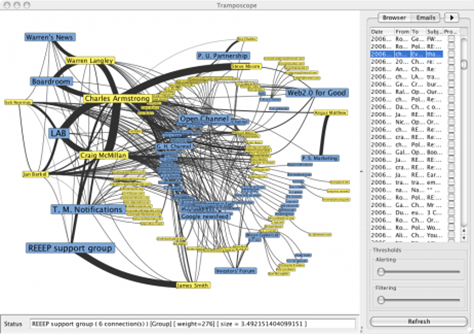Like Dennis, I wish that we weren’t stuck with the 2.0 suffix, but at least that did remind me to head over and re-read Andrew McAfee’s blog, He recently spent some time talking with HR Executives about Enterprise 2.0.
HR executives see all the bad things people can do, so I was expecting them to have a similarly cautious reaction to E2.0 (which is a concept at the intersection of people and computers). Instead, I found the group to be truly excited about the possibilities offered by emergent social software platforms. I got the strong impression that for these people phrases like ‘engaging the workforce’ and ‘our people are our most valuable asset’ are not corporate boilerplate; they are instead words that guide the work of HR leaders.
Indeed, Andrew, you are right. He also picks up on another important phenomenon, which he labelled lateralization. (I wonder if Andrew is suffering from a mild form of the German grammatical disease of nominalisation.)
Lateralization here means letting parties interact, communicate, and share information directly with each other without a lot of built-in filtering or moderation.
When I studied organisational design at university, A lot of it was top-down theory.
I left university with the image that the board members and the HR “gurus” would shape the organisation and its culture from above. It turned out in most organizations the HR folks just get to hold the poles, but anyway…
The informal networks that are the real life blood of the organisation have basically laid hidden, until now.
Nick Carr explored this relatively recently.
If you scratch the surface of any business, you’ll find two very different organizations. There’s the formal organization – the one that can be represented by the boxes of an org chart. And then there’s the informal organization, the one shaped by the day-to-day interactions of employees – conversations in hallways or in airport lounges, exchanges of messages through email and voicemail, glances and whispers in meetings.
This is exactly why HR should be very interested in social networking, both in the workplace and beyond.
Nick goes on.
Because they seem so natural to use, the social networks end up being incredibly sensitive mechanisms for recording the real life of a human organization. They serve not only as a flexible communications medium but as a means for identifying, refining, and recording valuable information. They do what corporate systems so often fail to do: they make the codification and sharing of valuable information easy.
He must have been in a really good mood when he wrote that, it has a breathless, almost teenage excitement missing from his normal rather acerbic style, but he is spot on.
Much as Facebook’s lofty valuation is based on their assumed ability to provide remarkably targeted advertising, HR departments that are able to effectively mine the corporate social graph will be tremendously valuable. Yes, there are challenges with privacy, adoption, and so on, but a strong online social network analytics within a corporation would enable HR to do some seriously deep study of the organisation’s strengths and weaknesses.
I had a chat the other day with Charles Armstrong of trampoline systems, and despite a few Vista challenges, I got a glimpse into a toolset that would enable HR folks to really grasp the information flows within the organisation. If you could start to mash this stuff up with some formal organisation modeling tools…gosh.
I wrote a bit about Trampoline and organisational network analysis last year
The mind boggles. It may be time to dust off the sociology and statistics – Organisational Network Analysis may just be the next big thing. (well, okay it started in 1934).
If we assume a workplace with more intense levels of informal collaboration and then some lateralization is inevitable. The HR professional that is able to actually analyse this, and the impacts on the business will be key.
The sad reality though, is that too few HR organisations have a good grasp on the relatively simple challenge of the formal organisation structure. Formal organisation structures have largely spun out of control, job titles in many organisations today have become almost meaningless.
It seems that HR today needs to do two things here.
1. Get better discipline and control of the formal organisation structures. There are some great new tools to help visualise this. Check out these.
2. Start to focus on the informal, tacit flows. Lateralization is coming, faster than we think.




















